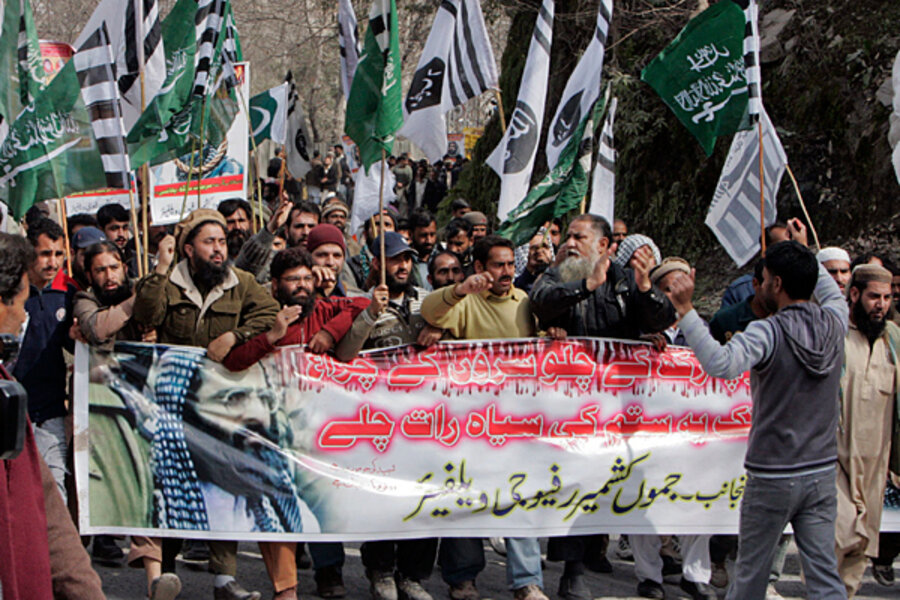Afzal Guru execution prompts clashes, leaving three more dead in Kashmir
Loading...
| Srinagar, India-controlled Kashmir
Three young people have died in violence in Indian-controlled Kashmir despite a curfew that continued for a third day Monday following the execution of a Kashmiri man convicted in a deadly 2001 attack on India's Parliament.
Mohammed Afzal Guru was hanged in New Delhi early Saturday. Ahead of the execution, authorities ordered people in most of the Indian-held part of the disputed Kashmir region to remain indoors indefinitely in anticipation of anti-India protests.
Despite the curfew, protests and clashes between troops and demonstrators broke out at a dozen places in the region today. Police and paramilitary soldiers fired tear gas and used batons to chase away rock-throwing protesters, police said.
Mr. Guru's execution is an extremely sensitive matter in the Himalayan region, where most people believe his trial was not fair. Several rights groups in India, and political groups in Indian Kashmir, also questioned the fairness of his trial.
Monday's protests coincided with the 29th anniversary of the execution of Mohammed Maqbool Butt, the founder of the pro-independence Jammu-Kashmir Liberation Front. Several activists tried to hold a procession in Mr. Butt's honor in Srinagar, the main city in the region, but police chased them away.
An Indian court convicted Butt of killing an intelligence officer and he was hanged in 1984 in the same New Delhi jail where Guru was executed.
In Watergam village near the town of Sopore, which was Guru's home, a 12-year-old boy, Obaid Mushtaq, died early Monday of injuries after police and paramilitary troops fired tear gas shells and bullets a day earlier to disperse an angry crowd, hospital official Aijaz Mustafa said. He said an 18-year-old boy injured in the clashes was on life support. At least two other people were also injured, police said.
Another young man died in Sumbal village in northern Kashmir yesterday after he jumped into a frigid river while trying to run away from troops who were firing tear gas and swinging batons. The body of a high school student who had been missing since Sunday's protest was also recovered from the river today, police said.
Thousands attended the funeral processions of the two young men today, shouting slogans such as "We want freedom."
Tens of thousands of security troops were fanned out across the Himalayan region, and metal barricades and razor wire blocked all major roads.
Cable television and mobile Internet services were shut down in most parts of the region and Kashmir's nearly 60 newspapers were unable to publish.
Showkat Ahmed Motta, the editor of an English-language newspaper, Kashmir Reader, said it printed its Sunday edition but police seized the copies.
"Police gave us verbal orders not to publish for four days," he said.
A local police official denied that any newspapers were stopped from publishing, but said the strict curfew may have prevented copies from reaching readers. He declined to give his name.
Anti-India sentiment runs deep in Muslim-majority Kashmir, which is divided between Hindu-dominated India and Muslim-majority Pakistan but is claimed by both nations.
Since 1989, an armed uprising and an ensuing crackdown in the region have killed an estimated 68,000 people, mostly civilians.
Guru, the man executed on Saturday, confessed in TV interviews that he helped plot the attack on India's Parliament that killed 14 people, including the five gunmen, but later denied any involvement and said he had been tortured into confessing.
Government prosecutors said Guru was a member of a Pakistan-based militant group, Jaish-e-Mohammed, a charge that Guru denied.
Guru had been on death row since being convicted in 2002. Subsequent appeals in higher courts were rejected, and India's Supreme Court set an execution date for October 2006. But his execution was delayed after his wife filed a mercy petition with India's president. That petition, the last step in the judicial process, was turned down last week.
Indian officials said Guru's family had been informed of his imminent execution by express mail, but the family said it learned of it only through television news.
John Samuel, the head of Indian Kashmir's postal department, said the letter, posted in New Delhi on Feb. 8, was delivered to Guru's family today.
Indian Kashmir's top elected official, Omar Abdullah, expressed anger that authorities denied Guru's family a last meeting and warned the hanging could lead to further unrest in the volatile region.
"I wish we were the ones authorized to give the news to the family — we owed him that much," Abdullah told CNN-IBN news channel on Sunday.
After the execution, Guru was buried in the prison compound.
The secrecy with which Guru's execution was carried out was similar to the execution in November of Mohammed Ajmal Kasab, the lone surviving gunman of the 2008 Mumbai attacks. Kasab, a Pakistani citizen, was buried in the western Indian prison where he was hanged.







